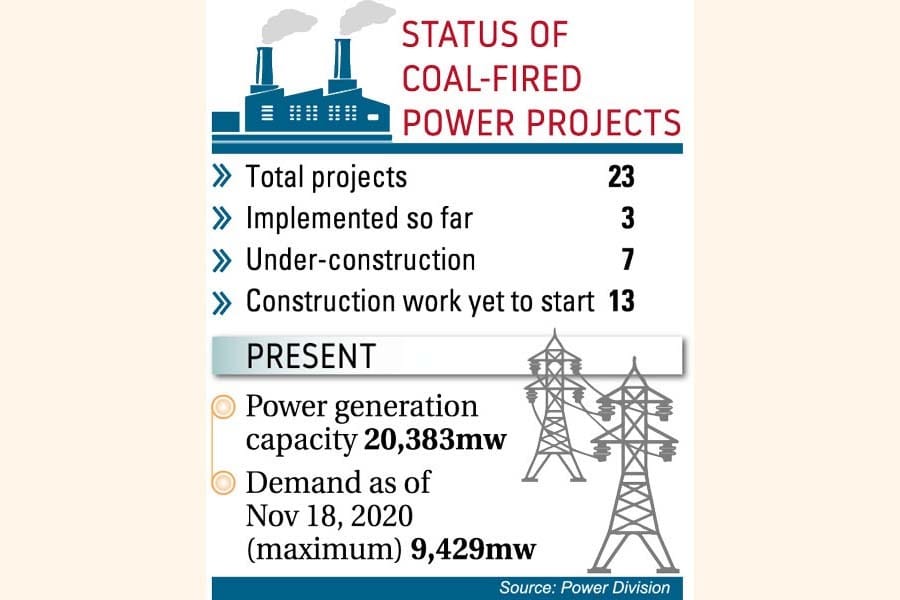The Power Division will soon seek suggestions from the Prime Minister about the fate of under-construction and proposed coal-fired power plant projects.
The division under the Ministry of Power, Energy and Mineral Resources, or MPEMR, is now preparing a detailed document on the latest status of the country’s all the 23 coal-fired power plant projects.
“The document will be placed soon to the Prime Minister’s Office to get advice from the Prime Minister,” a senior official at the Power Division told the FE on Thursday.
Sources said the widening gap between the country’s overall electricity generation capacity and demand has prompted the government to review the status of such plants and take necessary decision in this regard.
According to statistics of state-run Bangladesh Power Development Board, or BPDB, the countrywide electricity generation during the day peak hours on November 18, 2020 was around 7,952 MW and in the evening peak it was around 9,429 MW, which are less than half of the country’s overall electricity generation capacity of around 20,383 MW.
Among the 23 coal-fired power plant projects, three plants – two at Barapukuria having a total capacity of 525 megawatt, or MW, and one 1,320 MW capacity plant of Bangladesh China Power Company Ltd, or BCPCL, at Payra are already implemented.
Seven government, private and joint venture coal-fired power plants are at under-construction phase, which are: first phase of Matarbari 1,200 MW ultra super critical coal-fired thermal power plant of Coal Power Generation Company Bangladesh Ltd, or CPGCBL, Chattogram 1,224 MW of SS Power Ltd, Barisal 307 MW of Barisal Electric Power Company Ltd, Jharkhand 1,600 MW plant of Indian Adani Power Ltd, Maitree 1,320 MW super thermal power plant of Bangladesh India Friendship Power Company Ltd, or BIFPCL, Payra 1,320 MW thermal plant of BCPCL and Patuakhali 1,320 MW plant of Rural Power Company Ltd – Norinco International Power Ltd.
The progress rates of the projects range between 16 per cent and 52 per cent, said sources at the Power Division.
The construction work on 13 coal-fired power plants is yet to start. These include: second phase of Matarbari 1,200 MW ultra super critical coal-fired thermal power plant of CPGCBL, Patuakhali 1,320 MW plant of Ashuganj Power Station Company Ltd, or APSCL, Uttarbanga 1,200 MW super thermal plant of APSCL, Maowa 522 MW plant of Orion Power Ltd, or OPL, Gazaria 635 MW plant of OPL, Dhaka 282 MW plant of Orion Power and Associates, or OPA, Chattogram 282 MW plant of OPA, Khulna 565 MW plant of Orion Power Khulna Ltd, and Mirsorai 1,320 MW plant of the HongKong’s consortium of Hangzhou Jinjiang Group Co Ltd, Hangzhou Zhengcai Holding Group Co Ltd and Jindu Energy Equipment.
The construction work of Moheshkhali 1,320 MW plant of Bay of Bengal Power Company (pvt) Ltd, Moheshkhali 1,320 MW plant of BPDB, Bangladesh-Singapore 700 MW plant of CPGBL, and CPGCBL-Sumitomo 1,200 MW ultra super critical plant of CPGBL has not also started yet.
The government is also considering revisiting the Power System Master Plan, or PSMP, within a couple of years.
A senior official said the Power Division is not willing to give permission now to set up new power plants unabatedly, considering that the existing plants are enough to meet the demand for power at least for next one decade.
A high-powered government committee has recently recommended the pause in the approval process of new power plants.
The committee stated that the existing power plants, including those under construction, are enough to meet the country’s electricity demand over the next one decade.
The committee, headed by Director General of state-run Power Cell Mohammad Hossain, has revealed that the country’s electricity demand would be around 29,619 megawatt (MW) by 2030 with the efficient use of energy.
The existing PSMP projected the power demand at 40,000 MW by 2030.
If the government continues to award approval to new power plants, the volume of surplus electricity would be enormous, for which extra payment would also have to be made, the committee said.
If all the power plants, now in the pipeline, come on line, some 30,000 MW of electricity would be available with the national grid by 2030.
Separately, the government has also started considering export of electricity to neighbouring India to utilise the surplus electricity.
The Joint Steering Committee, or JSC, of the two countries already discussed the issue last year to strengthen bilateral electricity trades in future.

